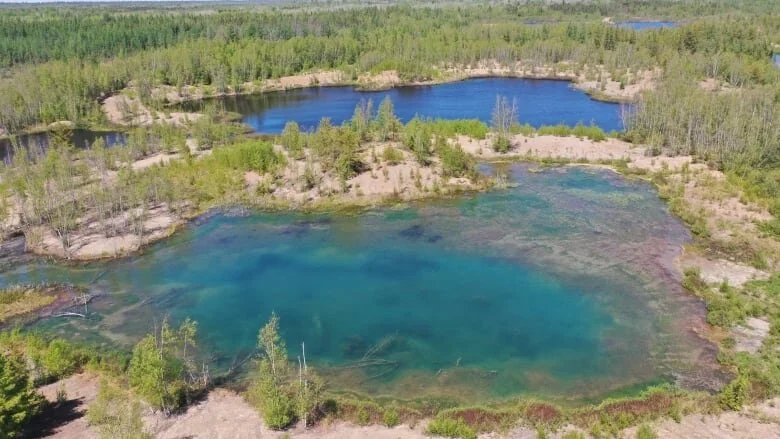The tap water in the Regina and Moose Jaw areas might smell funky and taste a little off these days, but the people responsible for the water say it's still safe to drink. There has been a prolonged and severe bloom of cyanobacteria (blue-green algae) at Buffalo Pound Lake, which is where the tap water comes from, "These organisms produce some compounds, chemical compounds, that produce the taste and odours that people describe as algae or musty," said Blair Kardash, who is the laboratory manager at the Buffalo Pound Water Treatment Plant.
What is that smell? Buildup of organic matter causing stench, discolouration at Regina's Wascana Creek
Walking around Regina's Wascana Creek can be a tranquil, meditative experience — until an offensive odour wafts into your nostrils. For several weeks a potent smell has been coming from parts of the creek — which runs out of Wascana Lake — and the water has been discoloured. The smell and colour are being caused by a buildup of organic matter, according to Kurtis Doney, director of water, waste and environment for the City of Regina.
Tropical oasis in N.B.? Nope — just remnants of Minto's mining history
"Every one of these bodies of water are man-made — there's hardly any natural ones here," he said, adding that some of the ponds are more than 30 metres deep. Allison Enright, an assistant professor of aqueous and environmental geochemistry at the University of New Brunswick, has studied the water at the former coal-mining site. She said there are tiny sediment particles in the water, remains from the mining activity and invisible to the naked eye. "They tend to stay floating or suspended within the water of the lake, and then this interacts with the light on the surface and in the water body to give you this really bright blue colour," she explained. As for why some of the ponds are a different colour blue, Enright said it just depends how much sediment is in each body of water. Despite the peculiar hues, she said, it's not dangerous. "In this area, over several decades of efforts to remediate, the pH of this water has been made completely safe," she said.
Province 'serious about compliance' at Travellers Rest, P.E.I. wash plant
A potato wash plant in Travellers Rest is cleaning up its act, and the pressure is on after the province issued a directive letter in mid-January. P.E.I. Potato Solutions is getting ready to open a new, larger facility next month, said co-owner Austin Roberts. Neighbours have made numerous complaints to the provincial Department of Environment as well as Environment Canada regarding the plant’s practices over the years. On Dec. 26, a heavy rainfall, combined with other factors, caused a holding pond containing organic waste from the plant to discharge into the environment.
Wastewater spill from Travellers Rest business was an accident
A Travellers Rest business has taken responsibility for a recent wastewater spill and is working to make sure it never happens again. The spill was noticed on Dec. 27, when Chris Wall, who lives in the adjacent community of New Annan, saw that the stream on his property was filled with smelly, grey water. “Seventy-five feet from the brook, I could smell the potato leachate,” said Wall, whose property is more than a kilometre from P.E.I. Potato Solutions, which has offered washing and sorting services to farmers across the Island since 2014. Wall snapped photos showing what he described as an unusual, thick, grey cloud of material in the stream, a tributary to the Barbara Weit River. He immediately suspected the wash plant and went directly to the culvert that exits the property, where he photographed dirty water flowing off-site. Wall reported what he saw to the Department of Environment.
A Mi’kmaq community’s fears of toxic water recede as Northern Pulp mill winds down
For decades, Pictou Landing First Nation has lived uneasily near an industrial plant emitting brown, foul-smelling waste and the effluent treatment facility they say causes respiratory and skin illnesses. Now, the mill is being mothballed. Ms. Francis, a member of Pictou Landing First Nation, fought for years to stop toxic wastewater from the Northern Pulp plant from being pumped into a tidal estuary next to her community. After decades of court battles, environmental studies and protests, people on the Nova Scotia reserve are hopeful they may one day be able trust their water and land again.
Nova Scotians urged to test well water after Health Canada sets new guideline for manganese
Spring run-off to blame for Edmonton's smelly tap water
If your tap water smells like chlorine, your schnozz has sniffed out a common springtime phenomenon in Edmonton. The spring thaw has made the city's drinking water more pungent than usual. Run-off from melting snow and river ice has washed higher than normal volumes of organic material into the water supply, said Shane Harnish, Epcor's senior manager of analytical operations. It's something workers at Edmonton's water treatment plants contend with every year. "What you're noticing is the chlorine smell in our water, and it's due to the chlorine reacting with some of this organic material," Harnish said in an interview Wednesday with CBC Radio's Edmonton AM.









